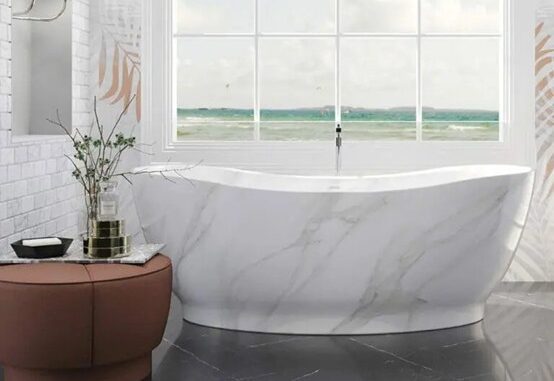
In today’s high-end bathroom design, a freestanding tub is far more than just a place to bathe—it’s often the centerpiece of luxury and style. With its sculptural presence and independent placement, a freestanding tub instantly elevates the atmosphere, becoming a statement of taste, craftsmanship, and individuality.
But with so many types available, which one truly defines luxury? The answer lies in the interplay between material, design, and the meticulous attention to detail.
-
The Material Matters: Nature vs. Technology
When it comes to determining what makes a freestanding tub truly luxurious, material is the first and most important factor. Among high-end tubs, three main materials dominate—and each tells its own story of elegance.
Natural Stone Tubs
Crafted from marble, granite, or travertine, natural stone tubs are inherently luxurious. No two are alike. Each one carries unique veining and coloring, evoking the look and feel of polished jade or carved mountain stone. They bring an organic, timeless appeal to a space. However, their substantial weight demands structural support and careful handling. Maintenance can also be intensive. Natural stone is best for those who seek a bold, earthy statement—and don’t mind the upkeep.
Copper and Brass Tubs
Metal tubs made from copper or brass exude old-world luxury. Hand-hammered finishes, antique patinas, or gold-plated accents create a refined, vintage charm. Over time, these tubs develop a one-of-a-kind patina that adds warmth and character. They also offer excellent heat retention. However, they are pricey, prone to oxidation, and require regular polishing. This style appeals to collectors and vintage-lovers who appreciate the romance of “classic luxury.”
Solid Surface Tubs
Solid surface tubs represent the modern fusion of beauty and technology. Made from high-quality composite materials, these tubs are cast as one seamless piece, offering the smooth elegance of stone without the weight or fragility. They provide a refined, soft-touch matte or satin finish that feels warm to the skin. Non-porous and easy to maintain, they’ve become the go-to material for contemporary luxury bathrooms. You get the aesthetic appeal of natural stone, the minimal upkeep of acrylic, and the freedom of custom shapes—all in one.
-
Design as a Statement: The Power of Silhouettes
Luxurious bathtubs aren’t just built—they’re designed to impress at first glance.
Traditional acrylic or cast-iron tubs are often limited to simple oval or rectangular shapes due to manufacturing constraints. While functional, they tend to lack visual drama.
In contrast, solid surface tubs offer designers full creative control. Think flowing teardrop curves, asymmetrical edges, thin rims, or sculptural bases. With precise molding technology, these tubs can feature seamless forms that mimic hand-carved art or flowing water. Details like integrated LED light channels, invisible drains, and built-in shelves enhance both aesthetics and function.
Metal tubs, while beautiful, are limited in curvature due to the constraints of forging and welding. Stone tubs can be carved into elegant forms but tend to appear bulky due to their mass.
If you’re after design freedom—something that looks more like a gallery sculpture than a bathtub—solid surface gives you the flexibility to achieve it.
-
The Craftsmanship: Luxury Lives in the Details
Luxury isn’t loud. It’s often hidden in the small, precise touches that make a piece feel refined and flawless.
Stone tubs, though natural and beautiful, may have inconsistencies like cracks or discoloration. Copper tubs are handmade but can show weld lines or polish marks.
On the other hand, solid surface tubs are engineered to perfection. The tub body is cast in one piece—no joints, no seams, no sharp edges. Overflow and drainage openings are often seamlessly integrated or hidden, maintaining the visual purity. The surface is polished until buttery smooth to the touch, and every curve is consistent, symmetrical, and satisfying.
These “zero-defect” details create a sense of luxury that’s not just seen—but felt.
-
Immersive Atmosphere: How It Shapes the Space
True luxury is more than just a beautiful object—it’s how the object shapes its surroundings.
Stone tubs, due to their size and weight, require large, reinforced bathrooms. Metal tubs, with their antique flair, look stunning but don’t always harmonize with contemporary interiors.
Solid surface tubs, however, are masters of adaptability. Their minimalist silhouettes and soft colors blend easily into a wide range of design styles:
- In a minimalist space, their seamless body enhances visual calm.
- In a wabi-sabi or nature-inspired room, matte stone-like textures complement raw wood and concrete.
- With ambient lighting, their smooth surface reflects soft glows and shadows, creating a spa-like mood.
- Paired with matching solid surface vanities or shelving, they can create a unified design language across the entire bathroom.
No matter the setting—by a window with a view, in an open-plan layout, or in a cozy corner with radiant flooring—solid surface tubs offer a luxurious soak wrapped in ambiance.
Conclusion
So which freestanding bathtub is the most luxurious?
While every material has its unique charm, solid surface tubs strike the most balanced blend of beauty, comfort, performance, and design freedom. They don’t shout luxury—they whisper it through softness, seamlessness, and presence.
True luxury isn’t about excess. It’s about how a product enhances your everyday experience—visually, physically, and emotionally. And that’s exactly what a well-crafted solid surface tub delivers.
References: The Luxury Appeal of Solid Surface Tubs
→ Stay ahead — browse more articles on USADailyChronicles.com.

